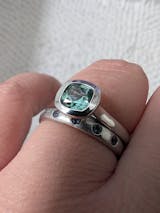I got the setting in platinum and chose a cushion cut green lab sapphire. It's understated yet sparkly, and goes well with me wedding band. It's just the ring I've always wanted!
Lovely ring. Communication was amazing. I got the matte finish and picked my gemstone. Beautiful and one of a kinf. Konstanze was wonderful to work with!
Beautiful one of a kind stone. In love.
I will never buy from another jewler, the quality and commitment to excellence cannot be beat!
I had come across Nodeform prior to getting engaged and had sent the ring to my partner for when he was ready. It was perfect.
Unfortunately, I misplaced the ring a few months after I found it. Konstanze was wonderful to work with on a replacement and the matching wedding band. I love this ring so much we bought it twice!












